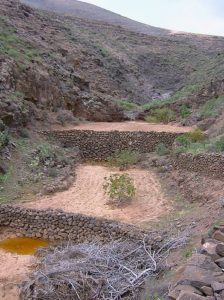A new edition of the book “Los Cultivos Tradicionales de la Isla de Lanzarote. Los Granos: Diversidad y Ecología (Lanzarote’s Traditional Crops. The Grains: Diversity and Ecology) ” was published in 2015. It was written by Jaime Gil González in collaboration with Marta Peña Hernández, Raquel Niz torres, and Elsa Rodríguez Rodríguez, with photographs by José Farray Barreto and coordinated by María Antonia Perera Betancort.
This book, which we share with this website’s users, was published by the Historic Heritage Service of the Island Council of Lanzarote..
Up until a few decades ago, agriculture guided the life of the islanders, defining their customs and even the time they could mingle with each other. This reality, firmly connected with the environment, started to vanish and most of the current generations do not even recognise it as part of their own culture.
As a matter of fact, this book aims to save the knowledge of ancient farming from disappearing and boost the rural memory. We are now witnessing a revival of economic activity in a field mostly related with food and wine, and this small yet significant progress must be strengthen.
In the words of the author: “This is a book about our people: their crops, fields, routines and hard work, and also the knowledge of the legacy they had passed on to us; the seeds that fed them, the soil they planted and farmed, and the structures that allowed to welcome water and earth.
Our current ignorance, along with maintaining what used to be called progress a long time ago, has condemned many of our past’s facets to oblivion. Who cares if a handful of peas are planted or not? Who cares if a road goes over a cliff, through a stonewall and some fig trees? Almost no one.
But the wall is not just any wall. It has a function: to hold the soil, specifically the soil holding the fig trees. Without the wall , the soil in it would have run down towards the sea, where fig trees cannot be planted. We could say that the wall was first formed by raising a first stack of rocks in the cliff, and when it first flooded, the wall started to hold the soil, a couple of centimetres at the most. Maybe the first person who crossed the cliff did not even think that fig trees may, in the future, grow there.
If we take a closer look at the handful of peas, we will find out that some are smooth, others wrinkly, white, green, small or big, and, if we were to ask Mr Juan Guillén or Mr Marcial Robayna, we will learn that each and every one of them is unique, that some grow slower and give small quantities, some grown even later, but give up more peas, that some come from Venezuela, and others are extremely old.
Maybe now someone else cares about the stonewall, the fig trees and the handful of peas. And if nobody cares, at least we will know what we do not care about and will not destroy it out of pure ignorance.
Follow this link to download the book: Lanzarote’s Traditional Crops.
Related news: Presentation of the digital reedition Lanzarote’s Traditional Crops.









No Comment
You can post first response comment.